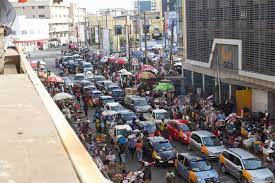Accra tops in Upper Respiratory Tract Infections cases
It is the country’s commercial centre and capital. Almost half of Accra’s dust, very tiny particles concentrations are attributable to road transport, 39 per cent, which is linked to inadequate public transport infrastructure.
- Advertisement -
Upper Respiratory Tract Infections, myalgias and other health conditions top Out-Patient Department (OPD) morbidity cases in the Greater Accra region in the last three years.
Upper Respiratory Tract Infections (URTI) affect the upper part of one’s respiratory system, including nose, trachea, lungs, and diaphragm, which work together to facilitate breathing.
- Advertisement -
A total of 13 local Assemblies in the region have recorded URTI as a top three OPD morbidity cases in the last three years.
- Advertisement -
Dr. Louisa Ademki Matey, the Municipal Director of Health for Ayawaso West Municipality, said in an interview with the GNA that URTI OPD morbidity cases had nearly doubled between 2021 and 2023.
“This is a disturbing trend and of great concern to us. The cases have actually increased consistently from 13,368 to 25,789. Now we are dealing with a double burden of diseases,” she said.
Dr Matey said air pollution had a connection with non-communicable diseases like URTI, explaining that inhaling poor air that had small particles get into one’s blood stream and impair its functions as well as other organs.
“In as much as air pollution has a link with URTI, we at this Health Directorate from now are going to examine the data, connect with the facilities to look at the risk factors, the conditions closely segregate the data, and take more history of persons with the conditions,” she said.
Mr Desmond Appiah, the Country Lead of Clean Air Fund- Ghana, said although the URTI could be linked to air pollution, the disaggregation of the data and further probing would help inform decision makers at the local Assemblies, the areas that need specific intervention to deal with the cause.
“…Great to have this piece of information and with this, we can begin to interrogate and appreciate what the issues are. This Municipality is linked to almost all the major highways,” he noted.
He said the Municipality was part of the 13 districts in Accra involved in the Breath Cities clean air initiative that aimed to reduce air pollution, slash carbon emissions, and enhance public health.
- Advertisement -
The Municipal Chief Executive, he said, had signed up to the initiative, which among other supports include, providing low-cost sensors, capacity building and data analysis on air pollution to enable the Municipality leadership to take steps to ensure clean air for all.
Through an evidence-based strategy, combining data, policy, and community engagement, Breathe Cities has the ambitious goal of contributing to reducing air pollution by 30 percent on average across participating cities by 2030 compared to 2019 levels.
According to Clean Air Fund, such a bold reduction would prevent an estimated 39,000 premature deaths and around 79,000 new cases of asthma in children each decade, saving $107 billion in avoided hospitalisations and deaths.
Accra is Africa’s fastest growing city, and the capital of one the world’s fastest growing economies.
More than four million people live in the Greater Accra Metropolitan Area with a daily influx of 2.5 million business commuters.
It is the country’s commercial centre and capital. Almost half of Accra’s dust, very tiny particles concentrations are attributable to road transport, 39 per cent, which is linked to inadequate public transport infrastructure.
About 70 per cent of daily commuters in Ghana use privately run minibuses known locally as ‘Tro-tro’, which are often older, higher-emitting vehicles.
Privately owned vehicles account for the rest of Accra’s traffic congestion and exhaust fumes.
Because Accra’s vast networks of roads remain unpaved and dusty, tiny particle concentrations are produced through resuspended dust.
Source: GNA
- Advertisement -



